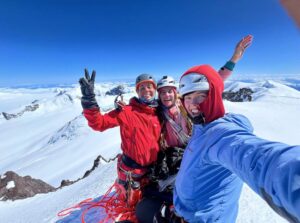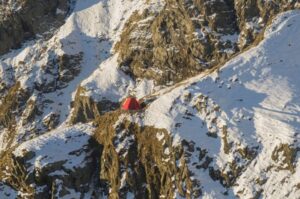The following article by Piotr Chmielinski appears on ExplorersWeb in its original and unedited form.
By Piotr Chmielinski
It was 114 years ago, at the end of May 1904, that fifty outstanding explorers including Adolphus Greely, Donaldson Smith, Henry Collins Walsh, Carl Lumholtz, Marshall Saville, Frederick Dellenbaugh, W. Furness and David Brainard met for dinner in New York City. This dinner became the genesis of one of the most famous and prestigious explorer organizations, uniting travelers, discoverers and researchers and promoting the work of exploration – The Explorers Club.
From its beginning, the Club has supported the research and education of all possible expanses: land, sea, air and space. Its members were the first in the world to reach the North Pole and the South Pole, the summit of Mount Everest, the deepest point of the ocean, and the surface of the moon.
“Probably the most powerful resource available to those who join the Club is fellowship with other members—a global network of expertise, experience, technology, industry and support.
The Explorers Club actively encourages public interest in exploration and the sciences through its public lectures program, publications, travel programs and other events. The Club also maintains research collections, including a library and map room, to preserve the history of the Club and to assist those interested and engaged in exploration and scientific research – that is how The Explorers Club mission and activity are defined on its website.
Today, under the auspices of The Explorers Club’s headquarters located in New York, more than 30 chapters support their activities. There are 20 US chapters and 12 international chapters dedicated for Africa, Australia/New Zealand, Canada, Central and South America, East and South Asia, Great Britain and Ireland, Hong Kong, Norway, Poland, Sweden, Switzerland and Western Europe.
One of the most distinctive visual symbols of The Explorers Club is its flag, that has been carried by the exploration expeditions from 1918. For the past 100 years it’s been a privilege and great honor to carry the EC flag. The flag is dedicated to the mission of the special importance for exploration, science and education. “Today there are 202 numbered flags, each with its own history” – as stated on the EC website.
And one more tradition continues since the beginning of the organization’s activity – the members meet annually at the dinner in New York, just as the founders of The Explorers Club did for the first time more than a century ago.

Richard Wiese – President of The Explorers Club. Photo. CBS This Morning
Richard Wiese acts as the President of The Explorers Club. It’s already been his second presidency since 2002 when he came to this office for the first time as the youngest president in the Club’s history. Richard Wiese is an explorer, traveler, journalist and documentary film producer, and the host of the popular TV show Born to Explore with Richard Wiese.
Presented below is a short conversation I had with Richard Wiese:
Q: What has changed in The Explorers Club since your first presidency?
A: The Explorers Club presidency is actually a series of one-year terms. In 2002, I was elected for the first of what ended up as four consecutive one-year terms. It’s been 13 years since I left the office and now this will be considered my second go around as president. Perhaps the biggest change at The Explorers Club has been the increased volume and rate of communication in the world of exploration. We’ve seen a big upsurge in the privatization of space and underwater exploration. I think this is good, as the public sector tends to be very creative compared to government offices.
Q: You have been involved in exploration for many years and everyone knows your program Born to Explore. What does “exploration” really mean to you? Who and what made you “born to explore”?
A: Being involved with over 170 Born to Explore episodes has certainly opened my eyes to many aspects of life on earth. But perhaps the biggest change in my life is that of being a father. I have revisited many rudimentary rituals and projects of exploration that I haven’t really thought about since I was a child. It’s been fun revisiting my original love for the outdoors and science. My father, who was the first person to fly solo across the Pacific Ocean in an airplane, and my uncle, Dr. Richard Lanza of MIT, are still to this day my main sources of inspiration for science and exploration.
Q: Is there any area of exploration that interests you in particular?
A: It’s hard to say that I’m more excited about one branch of exploration than another. Physical limitations have certainly changed the speed at which I work. I am less interested in racing to the summit of the mountain than meeting the people who live along the mountain. I also think bridge and cultural gaps have become more of a focus for me, as this affects the world we live in. I think that all explorers understand when you walk to the edge and take that first step into the darkness of the unknown, you must be comfortable with an uncertain outcome. If you’re not comfortable with the unknown, then it’s difficult to be an explorer.
Q: In your opinion what is the role that The Explorers Club should take in the development of contemporary world exploration?
A: In my lifetime, science and nature have never been under such siege.Our world needs scientists and explorers more than ever before.I am proud to say, since 1904, The Explorers Club has stood for innovation, conservation and the value of different cultures. Our members make a difference.
Q: What plans/mission have you set yourself for the second presidency of The Explorers Club?
A: I will continue to advocate for science and exploration. As our world has become more tribal and nationalistic, I hope to give voice to cultures and people that do not have a world stage to speak from.
I would like to see the Club continue to grow and include cultures and races that have not previously been that visible in Western Europe and America.

Explorers Club Flag number 146 was carried in 2000 by the expedition to the permanent (all year) source of the Amazon in Ticlla Cocha (Apurimac). On the photo from the left (all EC members): Piotr Chmielinski, Marek Kamiński and Ned Strong. Photo. Zbigniew Bzdak

Richard Wiese (second from left) together with Piotr Chmielinski, Zbigniew Bzdak, Michael Manyak, Marcin Jamkowski (all EC members) at Vulcan Ampato and Colca Canyon, Peru – 2006. Photo Zygmunt Malinowski

Explorers Club Flag number 44 was carried by the expedition to the seasonal sources of the Amazon (2012 and 2013) located at Cordillera Rumi Cruz. Mantaro River. On the photo from the left: Boris Trgovcich, Piotr Chmielinski (EC), James Contos (EC), Max Chmielinski (EC) and James Duesenberry. Photo. Piotr Chmielinski





